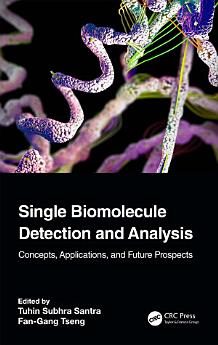Single Biomolecule Detection and Analysis: Concepts, Applications, and Future Prospects
આ ઇ-પુસ્તક વિશે
This book-
- Discusses techniques of single-biomolecule detection, their advantages, limitations, and applications.
- Covers comprehensively several electrochemical detection techniques.
- Provides single-molecule separation, sensing, imaging, sequencing, and analysis in detail.
- Examines different types of cantilever-based biomolecule sensing, and its limitations.
Single Biomolecule Detection and Analysis covers single-biomolecule detection and characterization using micro/nanotechnologies and micro/nanofluidic devices, electrical and magnetic detection technologies, microscopy and spectroscopy techniques, single biomolecule optical, and nanopore devices. The text covers key important biosensors-based detection, stochastic optical reconstruction microscopy-based detection, electrochemical detection, metabolic engineering of animal cells, single-molecule intracellular delivery and tracking, terahertz spectroscopy-based detection, total internal reflection fluorescence (TIFR) detection, and Fluorescence Correlation Spectroscopy (FCS) detection. The text will be useful for graduate students and professionals in diverse subject areas including materials science, biomedical engineering, chemical engineering, mechanical engineering, and nanoscience. Discussing chemical process, physical process, separation, sensing, imaging, sequencing, and analysis of single-molecule detection, this text will be useful for graduate students and professionals in diverse subject areas including materials science, biomedical engineering, chemical engineering, mechanical engineering, and nanoscience. It covers microscopy and spectroscopy techniques for single-biomolecule detection, analysis, and their biomedical engineering applications.
લેખક વિશે
Tuhin Subhra Santra is an Associate professor in the Department of Engineering Design at Indian Institute of Technology Madras, India. Dr. Santra is a tenure track "Honorary Visiting Professor" at National Tsing Hua University" Taiwan from 2018 to 2023, and he was a "Visiting Professor" at University of Cambridge, UK in 2019. Dr. Santra received his PhD in Bio-NEMS from National Tsing Hua University (NTHU), Taiwan in 2013 and he was a post-doctoral researcher at the University of California, Los Angeles (UCLA), USA, from 2015 to 2016. His areas of main research interests include Bio-NEMS, MEMS, single-cell technologies, single-biomolecule detection, bio-micro/nano fabrication, biomedical micro/nano devices, nanomedicine, etc.
Dr. Santra served as a Guest Editor for Frontiers of Bioengineeringand Biotechnology 2021, Cells, MDPI 2021, 2020; International Journal of Molecular Science (IJMS) 2018, 2017, 2015; Sensors Journal 2016; Journal of Molecules 2016; and Journal of Micromachines 2020, 2019, 2013, among others. Dr. Santra has received many honors and awards such as "Wellcome Trust/DBT India Alliance Fellowship" in 2018; Honorary Research Fellow from National Tsing Hua University, Taiwan in 2018; IEEE-NEMS best conference paper award in 2014; etc. Dr. Santra has published more than 45 international journals, has 25 US, Taiwan, and Indian pending/ approved patents, 8 books, 20 book chapters, 20 proceedings, in his research field.
Fan-Gang Tseng Fan-Gang (Kevin) Tseng received his PhD in Microelectro Mechanical System (MEMS) from University of California, Los Angeles, USA (UCLA). He became an Assistant Professor in Department of Engineering and System Science, National Tsing Hua University (NTHU), Taiwan from August 1999. Currently, he is a Professor in the Department of Engineering and System Science (ESS). He is a Deputy Director of Biomedical Technology Research Center, NTHU, form 2009. He is also an affiliated Professor in Institute of Nanoengineering and Microsystem (NEMS), NTHU, and Research Fellow in Academia Sinica, Taiwan. Dr. Tseng focuses his research area in MEMS, Bio-MEMS, Nano-biotechnology, Nanomedicine, Fuel Cell, MEMS packaging and Integration. Dr. Tseng is in Editorial board of Applied Sciences from 2010, open Micromachine Journal 2009, etc. Dr. Tseng received many awards such as outstanding in research award from National Science Council, Taiwan 2010–2013, iCAN Taiwan competition award, Ton-Yuan innovative competition award, the best project award, NTHU outstanding in research award, 2005–2007, National innovation award, First class research award from National Research Council 2005–2008, outstanding teaching award 2003, new faculty research award and many more. Dr. Tseng has published 8 books/book chapters, more than 40 US and Taiwan patents. Also he has published more than 200 international Journal papers and 350 International Conference paper/proceedings related to this field.




